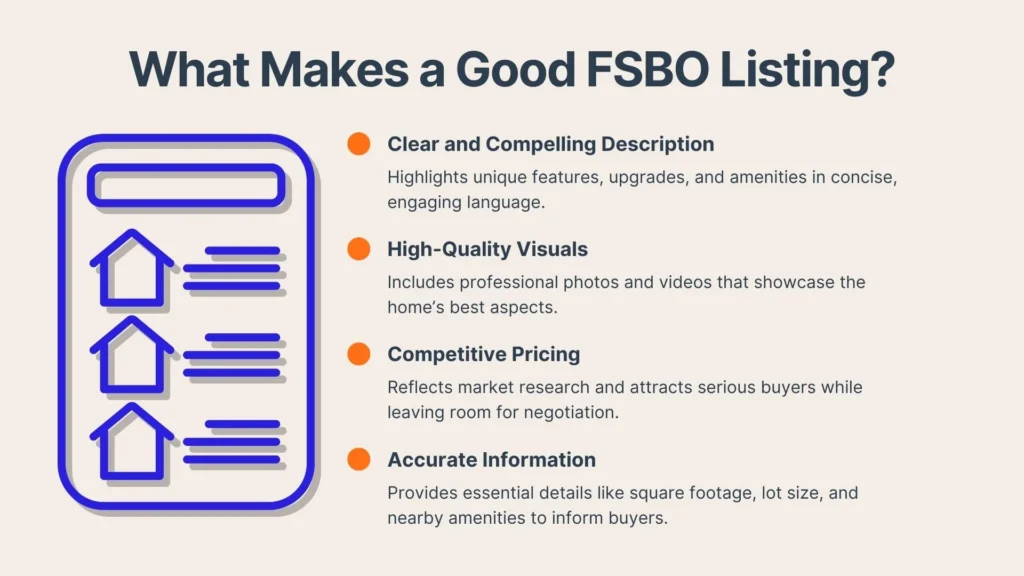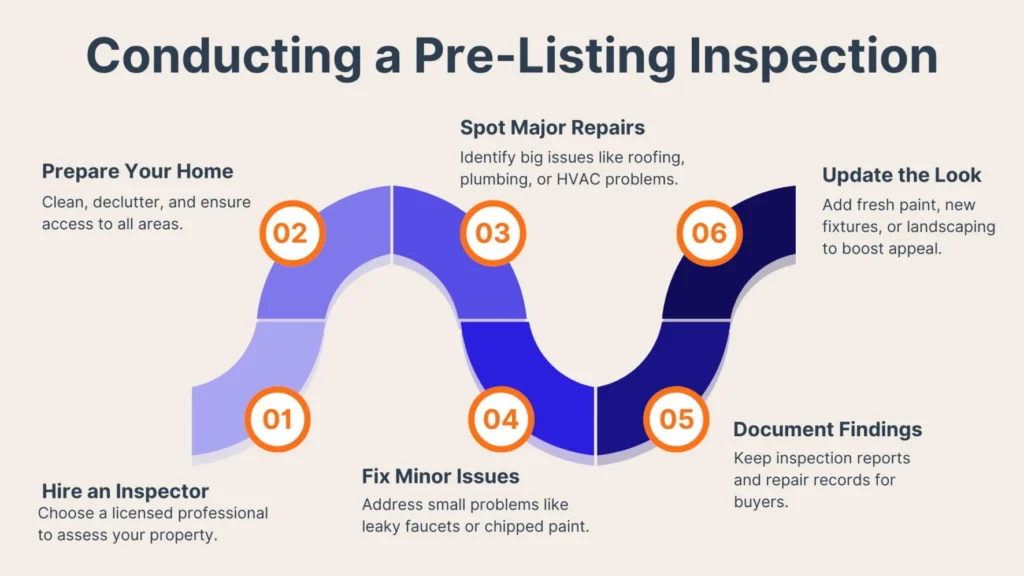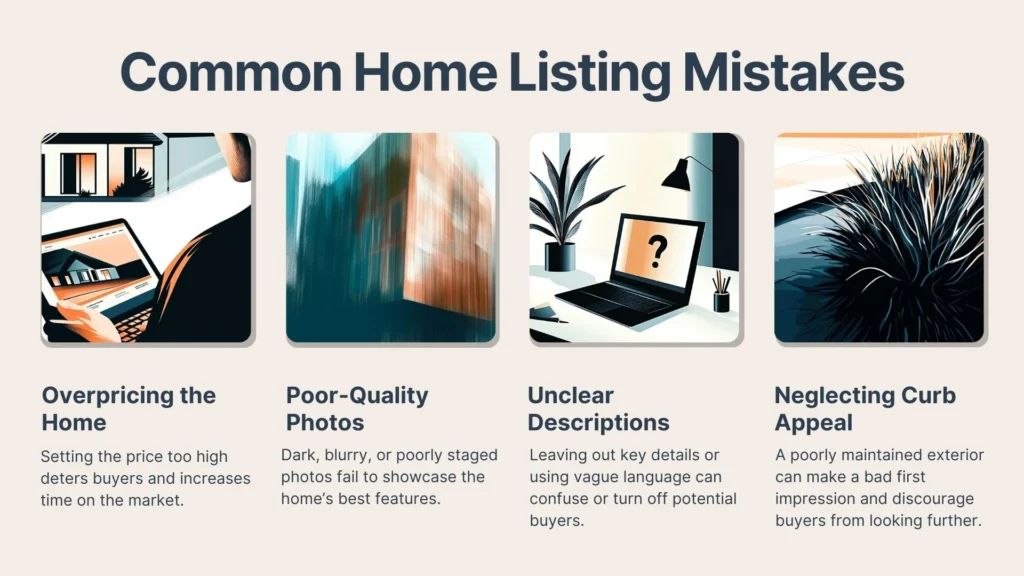Selling your home can feel overwhelming—especially when you're handling everything on your own, from pricing and staging to marketing and managing legal paperwork. Crafting a solid plan is essential to help you navigate these tasks and stand out in a busy market.
In this guide, we’ll cover everything from understanding why a great listing matters to managing buyer inquiries and all the intricate details in between, so you can move forward with confidence.
Let’s start by exploring why a high-quality listing can make all the difference in your selling success.
Why a Great Listing Matters
A stellar listing is more than just a quick ad for your home—it’s your property’s grand entrance. Potential buyers often form strong opinions based on their first online impression, so your listing needs to shine. In a market saturated with options, an appealing listing helps your home compete.
When a listing features crisp photos, concise details, and a friendly tone, it sends the message that you’re a responsible and attentive seller. Buyers tend to trust and revisit listings that feel polished.
A clear, professional-quality listing highlights your home’s strongest points and answers common buyer questions. This transparency can help you dodge lowball offers and increase your chances of attracting serious buyers.
Next, let’s see how you can prepare your property to give the best possible impression.

Prepare Your Home for Listing
You might feel tempted to snap pictures and post them right away, but investing a little extra time in essential prep work can really pay off. This includes tackling repairs, sprucing up your home, and choosing a fair price that accurately reflects your property’s value.
9% of sellers emphasize preparing or fixing up their home before listing. That figure highlights why it’s so important to handle maintenance, boost curb appeal, and set the right asking price. Amidst a sea of other sellers with similar properties, having a more visually appealing, well-maintained home can make all the difference in the time spent on the market.
In the next sections, we’ll dive deeper into these strategies so you can feel confident about making a strong first impression on potential buyers.
Conduct a Pre-Listing Inspection
Before you set a price, it helps to know the condition of your home inside and out.
- Spot Repairs and Upgrades: A thorough inspection may reveal hidden issues like roofing or electrical problems. Resolving these in advance can boost your home’s value and avoid unpleasant surprises later.
- Focus on Structural and Cosmetic Fixes: Don’t forget that small cosmetic updates like new paint, updated fixtures, or refreshed landscaping can greatly improve your home’s overall appeal. Think of it as setting the stage for a more inviting atmosphere.

Stage Your Home
Staging highlights your home’s best features and helps buyers picture themselves living there. If you’re not working with a professional stager, aim for a clutter-free, welcoming environment.
Small touches can create a big impact. Remove personal items, add fresh flowers or a subtle scent, and arrange furniture to make rooms feel more spacious.
Set the Right Price
Finding a price that’s both realistic and profitable can be tricky. Start by comparing recently sold homes similar to yours in size, location, and condition.
- Look at Comparable Sales: Online databases, real estate apps, and local property records can help you spot trends in your neighborhood.
- Use Online Tools Cautiously: Sites offering automated estimates are useful for a rough idea, but remember that upgrades or unique features can affect your home’s real value.
- Strike a Balance: Price too high, and you might push buyers away; price too low, and you could leave money on the table. Aim for a figure that sparks interest while giving you a solid profit.
If you’re ready for a smarter way to tackle pricing – and every other part of selling – check out PropBox. Our AI-driven market analysis, strategic pricing, and automated negotiation aren’t just extras; they’re the new standard.
With your home prepared, it’s time to gather the information you’ll need for a compelling listing.
Gather Materials for Your Listing
Buyers crave clarity and honesty. Having essential details on hand makes it easier to answer questions quickly, boosting trust right from the start.
Create a Checklist of Must-Have Details
- Property Size, Age, and Key Features: Be accurate about square footage and highlight notable aspects, such as a newly renovated bathroom or a finished attic.
- Utility Costs, Taxes, and HOA Information: Buyers often want to know about monthly expenses and whether the home is subject to HOA fees or regulations.
- Community Perks: Mention nearby parks, schools, or shopping centers—these can be strong selling points.
Capture High-Quality Photos and Videos
Great visuals might be the most vital part of your listing, as they’re often the first thing buyers see.
- DIY or Hire a Pro?: If you have a decent camera (or a quality smartphone) and good lighting, you can shoot photos on your own. Still, professional photographers bring expertise in angles and lighting that really showcase a space.
- Video Tours or 3D Walkthroughs: n today’s online-driven market, a quick video tour or 3D walkthrough gives buyers an immersive preview, especially if they’re relocating from another area.
With your materials in order, the next step is writing a listing that captures attention in just a few lines.
Write a Compelling Home Listing
A well-written listing should be warm, concise, and transparent. You want to interest potential buyers enough for them to contact you or schedule a viewing.
Structure of an Effective Listing Description
- Headline That Pops: Try something like “Charming Cottage with a Spacious Yard” or “Modern Home Near Great Schools.” This invites buyers to learn more.
- Showcase Unique Aspects: If you have vaulted ceilings or an updated kitchen, don’t bury those selling points. Highlight them right away to hook readers.
- Keep Details Manageable: Provide the basics like the number of bedrooms, bathrooms, and standout features, but avoid a giant text block. Give a concise overview, and let your photos do some of the talking.
Avoid Common Listing Mistakes
- No Misleading Claims: If there’s a small flaw, be honest and let the price reflect it if needed. Overpromising only leads to disappointed visitors.
- Proofread for Errors: Typos and grammar slips can make your listing look rushed or unprofessional.
- Share Key Details: Don’t skip crucial features like a renovated basement or new windows. You never know what might appeal to a prospective buyer.

Choose the Right Platforms to List Your Home
Where you choose to post your listing can directly impact how many buyers you reach. A blend of digital tools and old-school approaches often works best, and you might be surprised at how effective each option can be when used strategically.
FSBO sellers use for-sale-by-owner websites (3%), social networking sites (3%), yard signs (12%), and the biggest number is from friends, relatives, or neighbors (18%) to market their homes. Whether you lean more toward digital platforms or prefer traditional methods, branching out can maximize your exposure.
Below, we’ll cover FSBO-friendly websites, social media strategies, and time-tested marketing approaches so you can decide which combination works best for you.
FSBO-Friendly Websites
If you’re going the “For Sale By Owner” route, websites like Zillow or specialized FSBO platforms let you maintain control. Posting on these sites also exposes your property to many active house hunters.
Social Media as a Marketing Tool
Platforms like Facebook, Instagram, and even TikTok can be surprisingly effective. A quick post with eye-catching photos can spark shares and attract potential buyers who aren’t necessarily looking on traditional real estate sites. Local community groups on Facebook are another excellent place to promote your listing.
Traditional Marketing Options
Don’t ignore tried-and-true methods like a “For Sale” sign or a newspaper classified ad. If your neighborhood sees plenty of foot or car traffic, a well-placed sign can quickly draw interest. Flyers in coffee shops or on community boards can also reach people who don’t spend much time online.
That said, if you’re ready to move beyond traditional approaches, discover how PropBox replaces outdated real estate methods with direct, AI-driven automation. No agents, no guesswork—just streamlined pricing, marketing, and negotiations you manage on your own terms. Sell your home faster, smarter, and commission-free with PropBox.
Now that your listing is live, how do you keep it fresh and engaging?
Promote and Manage Your Listing
Posting your home online and crossing your fingers isn’t enough. You need to stay on top of inquiries, update your listing when necessary, and engage with potential buyers to keep the momentum going.
Monitor and Update Your Listing
- Track Views and Comments: Online platforms typically provide data on how many people have viewed your listing or saved it. If you notice view counts dropping, consider freshening up your photos or rewriting parts of your description.
- Adjust Based on Feedback: If potential buyers keep asking about the finished basement, add more images or give extra details. Feedback is your guide for fine-tuning your listing.
Respond Promptly to Buyer Inquiries
Timely responses show buyers you’re organized and serious about selling. Answer questions thoroughly, be friendly, and offer additional details or documents if requested. A prompt, polite reply can set you apart from other sellers who might not respond quickly.
Host Open Houses and Showings
An open house is your home’s chance to shine in person. Set the stage by tidying up, eliminating odors, and creating a warm environment with soft music or light refreshments. A clean, welcoming space makes a positive impact on visitors.

If there’s a recent upgrade or a unique feature, don’t assume everyone will spot it. Share just enough info to help visitors appreciate what makes your property special. Encourage attendees to fill out a comment card or chat about their thoughts. Their impressions may inspire adjustments to your staging or listing details.
With your listing maintained and your open houses running smoothly, you’re in a great position to secure the best offer.
Conclusion
Selling your home starts with preparation: fix what needs attention, showcase your interior, and pick a price that’s both competitive and profitable.
Gather clear, accurate information on your property, then capture great photos to make your listing shine. Promote it through channels that fit your style—FSBO sites, social media, or even classic flyers. Finally, watch for buyer feedback, respond promptly, and hold inviting open houses.
If you want to cut costs and complexity, check out PropBox. We replace the old flat-fee FSBO approach with smart automation, seamless organization, and AI-driven reminders that guide you every step of the way. That means no 6% commissions, a faster sale, and full control over every decision—giving you more confidence and more money in your pocket.
